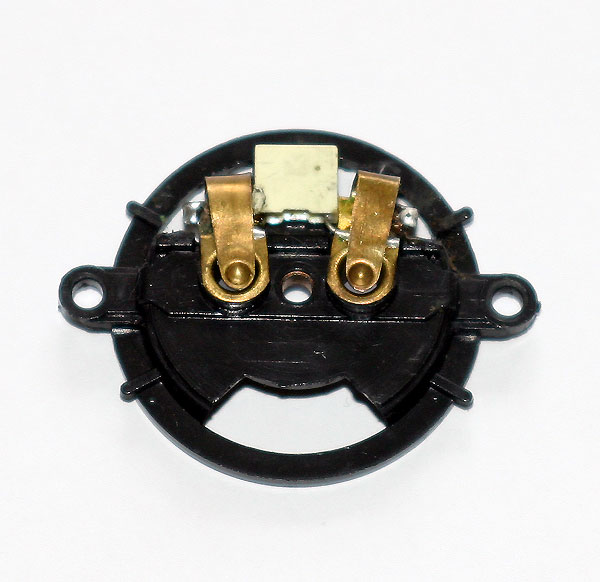
irishthump
-
Posts
1,840 -
Joined
-
Last visited
-
Days Won
7
Content Type
Profiles
Forums
Resource Library
Events
Gallery
Blogs
Store
Community Map
Posts posted by irishthump
-
-
Looking good Tony
Wednesday maybe?
Patience!
When my old man worked as a tailor and a customer ordered a new suit and wanted it in a hurry he woul say to them - "Quality - Quick - Cheap. Pick two!"
-
Glad you found the source of the trouble!
The leds are mounted on a flat circuit board that fits underneath the cab, it may be stuck to the bottom of the cab detail in those photos.
If you can't see where to solder the wire you may have to remove the other cab and check the wiring on the opposite end's light board.
Anyway, it's a simple enough fix.
-
Wonderful work, sir!

-
I'm no expert, but is this not a tad expensive?
http://www.ebay.co.uk/itm/331422674305?_trksid=p2055119.m1438.l2649&ssPageName=STRK%3AMEBIDX%3AIT
-
The 141's use leds and these usually don't flicker before blowing they usually die suddenly! I have a feeling it might be a dodgy PCB which I believe was an issue with a few of these locos. I've never stripped one of these locos down completely but I assume there are 2 leds at each end of the loco. According to the service sheet there's an led board that sits into each end so I imagine the leds are wired onto this.
It may simply be a loose wire so check that out first.
To check the led would require it being removed from the loco or you may be able to apply power to the ends of the wire feeding the led but be careful to use the correct voltage.
If it's the PBD that's at fault then the printed circuit powering the cab 1 lights may have burned out. It's possible to insert a jumper wire once you can identify the circuit but it would require some delicate soldering work.
-
The Maplins speaker running free air make's a big difference that's the way I run my sound locos. Try attaching the Maplins speaker to the inside of the roof below the the grill (don't forget to remove the grey plastic covering the underside of the grill) and sealing all the way around it with blue tack or copydex to stop any noise cancellation that makes a big difference. The sound from the top of the speaker fires out through the top grill and the underside of the speaker fires into the loco body but the speaker must have an air tight seal around it.
Although it's not in the picture I sealed around the bottom of the speaker with black mastic. But I will try mounting the speaker directly to the inside of the shell.
-
I also have some "sugar cube" speakers which sound incredible for their size, I installed one in a US loco and it sounds great. I plan to try one in a 141 soon and I'll post a video when I can.
-
Thanks for taking the time to make that clip and post it. Very interesting.
I noticed the horn at the beginning of the 142 segment sounded different to the horn at the end of the 165 segment.
If you got a chance sometime to post a clip with the braking sound on stopping and the flange squeal. If you are programming the LokSound yourself, are you able to extract the other channels from the MM recordings on ESUs web site (e.g. whistle, station announcement, brakes, etc).
I stand corrected on the horn sound! I programmed different horns for each engine so that explains the difference in tone. You're right in that any individual sound can be removed and switched with another from the ESU sound library. The sound file is the 071 file and I just switched the engine sound.
I'll do that when I get the chance, Noel. I presume you mean the braking sound as the engine comes to a stop? I deliberately filmed the locos standing still and used the manual notching function so as to give an accurate comparison between the two speakers.
-
I recently installed sound decoders in a couple of my MM 141's and I thought I'd post this little video comparing the sound from different speakers.
Both locos contain the same Loksound decoders and are both loaded with the same soundfile. The volume settings are identical on both.
MM142 is fitted with a bass enhanced speaker that can be bought from several suppliers. I removed the back from the housing to allow it to fit into the body without any surgery to the loco.

MM165 used a 4ohm speaker from Maplins and was a perfect fit into the cradle on the loco frame. These speakers are available from several other suppliers but I just happened to see them for sale in Maplins and picked up a couple at €4.50 each. The part no. is ABS-224-RC which is a 4ohm speaker but they also sell an 8ohm speaker (part no. ABS-216-RC) which is also suitable for the LOksound V4. (Both speakers will also work with Zimo decoders.)

One thing with this speaker is that you have to secure it into the cradle either through the screw holes provided or with some sticky mastic or Blu Tac. Otherwise the speaker will rattle like crazy!
Anyway here's the video, decide for yourself which sounds better. But I think the Maplins speaker as a but more low end to it.
-
From what I know their uncoupler is simply a small ramp that is raised by a solenoid or servo. There are neater was to uncouple stock to be honest.....
-
A small drone ( under 20kg) operated within 500m of the operator and not over 'congested' populated areas or near airports doesn't need any licenses.
Yeah, but it should....

-
Has anyone used neodymium magnets for uncoupling kadees and do they work well. Last layout I did I used the Kadee magnet, but I'm interested in using the neodymium magnets.
I think Boskonay has used them on his layout.....
-
I don't have a capacitor built into the circuit for the lights.
I have used the circuitry before and found it woks fine using the Hattons 8 PIN with Harness chips.
I just thought a capacitor might be a good idea as the Lima 201 has such poor pickup you might get some flickering, especially over pointwork.
Another issue is that I installed tail lights on a brake van which I controlled with a Hornby decoder. The lights were linked to F0 but every time there was a break in the pickup the lights would go out rather than flicker and you would have to turn them back on with F0. Apparently, some decoders "remember" function settings after a power interuption but some don't.
I got around the problem by wiring the Leds to the motor outputs on the decoder instead and using the throttle to turn them on and off!
-
I am doing something similar.
I am fitting a LIMA 201 with DCC directional lights.
Having ripped the motor and gears out, it will be towed/pushed on the end of my Push/Pull rake with motorised MK4 DVT.
The newer motor in the DVT, from a Bachmann Voyager, has no problem moving 6 coaches and the dummy 201.
It does look quite nice on the end of a rake.
I like that idea! Are you going to use some form of "stay alive" for the decoder?
-
Yep, it was a hornby hst , just re-read your thread, i did work on CV2 no noticable difference.
I'll see how it goes and revert to dc and sell if not happy.
Thanks for the feedback.
Bill
Have you tried different speed step settings? I have found that with certain decoders CV2 changes only work when the loco was set for 128 speed steps as opposed to 28.
-
I remember a thread on here where somebody had fitted a motor belonging to a CD-Rom unit to Lima BR HST and that made a massive difference to the Loco.
That was me, here's the link - http://irishrailwaymodeller.com/showthread.php/77-Graham-s-Workbench/page12#120
It's actually the Hornby HST. The running is vastly improved but it still suffers from poor pickup (although it has slightly better pickup then a Lima).
-
Its converted now and running fair to OK, I checked on the cap and its recommended to remove it which I did. The pickups, yes definately need more.
The 201 running in DC was pretty good but DC seems to be more forgiving than DCC, I now see why people say the old Lima motors weren't the best. I'll fit the lights in a week or two as the wife wants her table back. I ended up stripping the engine down to it component parts and doing a rebuild...cleaning and adding a small drop of oil where necessary. That helped . Its very poor on slow speeds and only when the notch hits 1.5 to 2 on the controller does it move. But once going it tears along and runs extremely well.
I remember a thread on here where somebody had fitted a motor belonging to a CD-Rom unit to Lima BR HST and that made a massive difference to the Loco.
Compared to the other three engines I've converted so far its actually a pretty poor runner . At this point its either rebuild the motor, static display or ebay and I save up for a MM Class 201 , 141 or 081.
I also converted an Athearn F7A unit and that runs like a fecking sports car and to me it seems to run better than it did on DC. I even fitted the led as the MARS light, I bought that unit 14 years ago in Canada along with a B unit , an SD40 and some freight cars. Far different motor though.
Worse comes to worse I'll jsut convert it back to DC running and sell it. I'll fit the chip to another loco.
Been fun though.
Bill
Have you tried adjusting the starting voltage for the decoder? This is CV2 but I'm not sure if it's supported on the decoder you used.
Personally I would'nt bother with this loco on DCC, it's just too much hard work to get it running well and even then the results won't be great.
You could also consider using the body on a different chassis. I think the Athearn SD45 is the closest fit and requires some work but as you know the Athearn chassis are reliable even with the stock motor.
-
Hi guys,
I'm going to be starting the switch-over of my Lima 201 to digital running, using a Digitax DH126. I'm going to fitting leds to replace the existing bulbs and also fitting red leds for the reverse lights.
Any thing I need to watch for? Is the capacitor fitted to the engine requried?
Bill
If you're talking about the capacitor that is installed across the motor contacts (the white square in the photo below) then yes, it should be removed before fitting a decoder as it will cause running problems.

Also make sure the loco runs as well as possible on DC before installing the decoder. If it's runs poorly on DC it will ten times as bad on DCC!
Power pickup is a problem on Lima locos, there is only pickup form one side on the motor bogie and the opposite side on the rear bogie. It may be worthwhile installing extra pickups on the rear bogie.
-
IT, I like the idea of drop-in and play rather than having to shave bits off speakers or the loco body. I wonder how it compares to the bass reflex speakers that members seem to speak highly of? Anyone happen to have compared these two speakers?
I plan to soon, I haven't had a chance to install a Loksound into this loco yet. But the speaker is the same one in the 071 which always sound fine to me. I'm sure you would get a bit more "low end" from a bass reflex speaker but I doubt it would make a huge difference.
I used the bass reflex in my other 141's but I refused to cut up the loco so I simply removed the back from the speaker. Did'nt seem to effect the sound.
-
You may get US chips at a slightly lower rate but you'd still be talking 90 euro plus. There are some for 40-50 quid mark with generic sounds but they (well to me, anyway) sound dreadful.
Hornby and Bachmann US are doing locos with cheap sounds but the former dont do any EMD sounds and the latter use tsunami sound boards which might not be transplantable. Irish Thump has an F Unit with tsunami sounds so he may be able to help there. They're limited in functions but the engine note is spot on for something like a 141 or 121.
Like Warbonnet says the Bachmann F units I have use a budget version of the Tsunami. I posted this video before, but here it is again....
The sound quality is the same as the high end Tsunamis, but there are very few other features. No start-up or shutdown sequence, and only horn and bell. The horn has 3 different sounds to choose from but none of them would pass for an Irish loco! However the decoder is fully adjustable for motor control and the engine sound can be adjusted for manual notching.
To be honest I wouldn't bother with trying to use US decoders for Irish diesels. The engine sounds are bang on for 121/141/071 and 201's but the lack of correct horns is a big problem. Another factor is that design of the Tsunami means you would have to remove the existing circuit board from a MM loco and wire in the Tsunami. Not a huge or difficult job but why bother when you can plug a 21 pin Loksound or Zimo straight into the existing circuit board?
-
The Zimo MX644D decoder can be bought for about €82 from German sites (i.e. £60), but you would need a Zimo programmer and sound files to burn onto it. Speaker for a 141/181 is about €6. No speaker needed for 071/201 as chassis include them.
That's where I find the ESU Loksound comes out ahead. The Lokprogrammer is around €140 and all the sound files are free to download from ESU. They have a large collection of European and American sound files (as well as miscellaneous sounds) which can be mixed and matched to any degree. The decoders are a bit more expensive, around €99 from some suppliers and come with a speaker (although the speaker is too large for 141/181 locos.
Maplins sell a speaker for €4.50 which is suitable.

It's a drop-in fit for the speaker cradle on the 141/181.

-
the feedback from rmweb, is that he hasn't bothered upgrading the UK sound files to V4 of the Zimo and hence requires V3,5, which is disappearing, maybe he has V4 versions of the irish sound files. have you an email for him ?
Mind you I dont think v4 is actually shipping as Zimo keep delaying it.
You're actually talking about ESU Loksound V3.5 and V4.
Mr Soundguy did the first 141/181 sound decoder which was available from DCC supplies and was loaded onto a Loksound V3.5. For whatever reason, Mr Soundguy stopped working with DCC supplies and started supplying the 141 sound file for Model Shop Belfast on Zimo decoders.
You're right though in that the Loksound V3.5 file was never modified to be loaded on to the V4 which was only becoming available at the time. The V3.5 is no longer produced but can sometimes pick them up second hand. I believe DCC Supplies still has the 141 sound file and can "re blow" a V3.5 if you can get your hands on one.
-
I posted many many times,video of my A class with
sound on this site.
Apologies, Enniscorthyman!

Yes I've seen your videos, I was just surprised no one had posted that particular video here.
@Noel: Sound does seem a little distorted. Maybe he just had the volume turned up for the benefit of the video.
-
Where can these now be purchased ?
I checked Mr Soundguy's website but he hasn't got these available yet. But he's obviously planning on releasing them soon.
.png.c363cdf5c3fb7955cd92a55eb6dbbae0.png)




enniscorthymans workbench
in Workbench
Posted
Had the same trouble with mine and it appears to be the crappy wheels that Dapol supply with the kits. I switched mine for Hornby wheels and the problems disappeared.